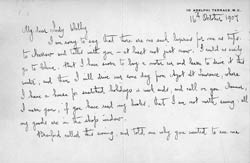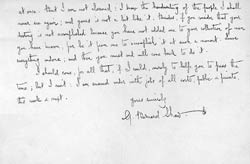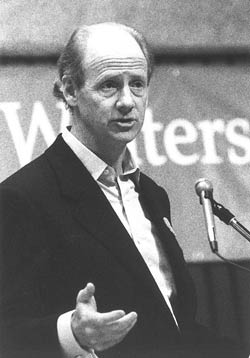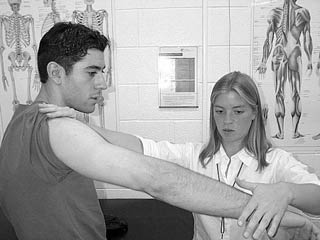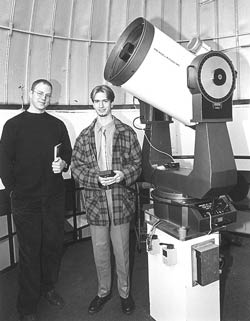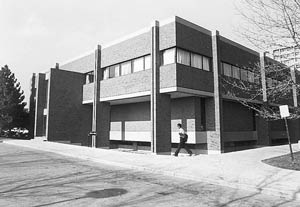
|

|
| | |
| | VOLUME 30, NUMBER 17 | WEDNESDAY, JANUARY 26, 2000 | ISSN 1199-5246 | | |
| | |||||||||||||||||||
|
|
By Sean Smith
Letter from George Bernard Shaw to One hopes that it is still clear what people were talking about at the turn of this century but perhaps documentary evidence will be needed for most to uncover the major topics of conversation at the turn of the last. Fortunately, for those interested, the Lady Victoria Welby fonds housed at York University Archives and Special Collections provides a unique view- point on "human thought" during the years spanning 1861 to 1912. By reading her rich correspondence with the likes of H.G. Wells, George Bernard Shaw, Bertrand Russell and many others, one can not help but divine a clearer picture of the discussions held in the living rooms of the privileged. Lady Victoria Alexandrina Maria Louisa Welby was born on April 27, 1837 to the Hon. Charles Stuart-Wortley and Lady Emmeline. She was an extensive traveler and there were few corners of the world which she did not visit. She was orphaned at the age of eighteen in Beirut and later served as a maid of honour to her god-mother Queen Victoria. She was an accomplished writer and founded the Sociological Society of Great Britain and the Royal School of Art Needlework. Lady Welby married William Welby-Gregory, a British politician, on Feb. 17, 1831. They resided in Lincolnshire where the Welby home was open to men of letters until the time of her death on March 29, 1912. Lady Welby was seen as an extraordinary figure and it has been written that she was "one of the most remarkable women of the Victorian age". Although she was not an educated woman herself, Lady Welby had an uncanny knack for "interpreting and translating into terms which she herself could appreciate the achievements of her contemporaries in the most diverse fields of investigation." (Spender, 1912) "She made acquaintance by degrees with man after man distinguished in things philosophical, theological, scientific, and social." (Winton 1912: 544) Lady Welby educated herself through the ideas of those around her and used her acquaintance with men of letters to improve upon her own ideas regarding the relationship between thought and language. In addition to having many correspondents, she also had numerous editors.
In her early years, Lady Welby wrote poetry and plays as well as keeping extensive journals in which descriptions of her travels can be found. She is best remembered, though, as being the author of several works on the new science of semiotics, or 'significs' as she termed it. Her best known works include Significs and Language (1911), What is Meaning? (1903) and Links and Clues (2nd ed. 1883). Lady Welby wrote the article on significs for the 11th edition of the Encyclopedia Britannica. To this day, however, her influence on the field of semiotics is disputed with the consensus being that her work was left unfinished at the time of her death. Despite remaining somewhat of an enigma, though, her works on the subject of semiotics have been cited next to those of Bertrand Russell.
With her value to the study of semiotics being unclear, perhaps her greatest legacy might be the Lady Victoria Welby fonds (F0433) housed at York University Archives and Special Collections. Acquired by the first The fonds also contains Lady Welby's research and reference notes and subject files dedicated to such areas of interest as "biology", "language and expression", "mental brain", and several dealing with "significs". There are also galley proofs of Francis Galton's paper on eugenics delivered to the Sociological Society including copies of Welby's comments on the subject. Undoubtedly, as H. Walter Schmitz has written in his introduction to the 1985 reprint of Welby's Significs and Language, "It is very evident that the Welby Collection can be of great value not only for the history of significs, but also for general questions pertaining to the history of religion, of science, and of civilization." It also stands as a rich testimony of the thoughts and trends which helped propel humanity into the now defunct 20th century.
Sean Smith is the archivist's assistant with York University's Archives and Special Collections.
| ||||||||||||||||||
|
|
Did You Know? * The York University Centre for Practical Ethics organizes workshops and conferences on practical ethics and develops professional programs to service community organizations through the Ethical Consulting Services. The centre was established in 1994 to further the research in the field and to support the teaching of practical ethics throughout York University. * The Summer Employment Fair of 2000 will be held on campus Thursday, February 3rd. This event, along with several others including the Student Career Week, is organized by York University Career Services. For more information see their Web site at www.yorku.ca/ careers/default.asp. * Theatre Professor Ines Buchli won the 1999 Kodak Canada Vision Award from Women in Film & Television, Toronto, for her short film Foxy Lady, Wild Cherry. Buchli's experience includes directing for the Shaw Festival, Theatre Passe Muraille and Necessary Angel Theatre. * In 1960 York University's first student enrolment was 73; in 1970 it was 16,860; the 1980 total was 24,293 students; and in 1990 York had 40,144 students.
| ||||||||||||||||||
|
|
John Ralston Saul at York to discuss democracy and culture
By Nishat Karim John Ralston Saul at Winters College Democracy, language, culture, nationalism and education were among the topics discussed when His Excellency John Ralston Saul paid a visit to York University on November 5, 1999. The cultural philosopher and writer participated in a dialogue with York's Professor Bruce Powe and Professor Maurice Elliott. As part of the Winters College Reading Series, the lively dialogue took place in the college Dining Hall where introductory comments were made by Powe. "John Ralston Saul is an extraordinary literary figure, and one of Canada's leading social and critical thinkers," said Powe. Following those remarks, Saul was introduced to the packed audience by Elliott. As a best-selling author, Saul has written books such as Reflections of a Siamese Twin: Canada at the end of the Twentieth Century (Viking Penguin, 1997), Voltaire's Bastards: The Dictatorship of Reason in the West (Penguin, 1993) and The Doubter's Companion (Penguin, 1995). Saul shared his well known belief that democracy is the best system because it is complicated, long, boring and requires time of citizens. Also during his visit to York, he discussed his view on culture being at the core of society. According to Saul, language, which is an example of culture, is extremely important to society, and a lack of it would create laziness among people. With his attentive audience of students, faculty and staff, Saul also discussed issues such as nationalism, focusing on Canada in particular. He urged people to think of Canada not as they would think of Paris or New York, but rather as unique. This, Saul said, would help us to stop seeing Canada as inferior, and instead allow us to see the certain marginality that exists as the strength of Canada. Saul also briefly discussed education with Powe and Elliott before opening the dialogue to the floor. It was with his 1995 Massey Lectures that Saul's growing impact on political and economic thought was established in Canada as well as internationally. His book The Unconscious Civilization (Anansi Press, 1996) won the 1996 Governor General's Literary Award for non-fiction. Saul was also recently named a Cevalier in the prestigious French Ordre des Arts et des Lettres. He is married to Her Excellency the Right Honourable Adrienne Clarkson, Governor General of Canada. Powe is the author of various works including Outrage: A Journey into Electric City. His writings have received worldwide recognition in the media and he is a sought-after speaker, lecturer and media commentator. Powe has been teaching at York University since 1987, and is currently serving as Academic Advisor for Winters College. As a professor of English, Elliott teaches in various areas, but primarily the poetry of the Romantic period and Irish writing in English. He served as department Chair between 1993-1999 and is University Orator and Member of the Board of Governors. Presently, he is on sabbatical until 2001.
| ||||||||||||||||||
|
|
York study shows impact of funding cuts on Ontario colleges By Cathy Carlyle Because of funding cuts over the last 10 years, class sizes have risen in Ontario community colleges, resulting in fewer services available to students. As if that weren't bad enough, students are being burdened with higher costs for postsecondary education, says a recently-released study. Reports from the university-based study show that staff at Ontario's 24 colleges has the capability and commitment to deliver well-educated and trained graduates. The problem lies in its ability to do so when funding cuts have eroded the system. "At a time when a nation's economic performance is increasingly determined by the education of its citizens, Ontario's decline in investment in education does not bode well for the future of hundreds of thousands of young Ontarians and the economic health of the province," said Carla Lipsig-Mummé, director of York's Centre for Research on Work and Society (CRWS), when the project findings were released. Repercussions from funding cuts will be felt even more strongly when the double cohort kicks in after Grade 13 is phased out in 2003, says the CRWS's incoming Associate Director Bob Drummond, professor of political science at York. "The double cohort comes at the start of a longer-term demographic bulge that will keep enrolment demand high into the 2020s and maybe even to the 2030s. "While the study was done at community colleges, I anticipate similar effects at universities," he said. "The Council of Ontario Universities and the Ontario Confederation of University Faculty Associations have noted the decline in tenure-stream faculty since the early 1990s and have warned of the negative consequences for university education and research." He added that cuts over the last six or seven years have led to a reduction in tenure-stream faculty numbers, "though the province has recently, with the so-called 'fair-funding' money, tried to make it a little easier to do some tenure-stream hiring". Other findings from the report: * 56.5 per cent of college teachers said they now have less contact time with students outside the classroom; * 71 per cent reported a decline in the quality of the curriculum covered and attributed it to the reduced number of weeks per course; * College teachers reported a shift in emphasis toward "self-learning" (self-taught classes in which students work independently); more than 61 per cent of those whose programs were affected by this trend felt that this shift had hurt the quality of their programs; * About 65 per cent of college teachers said they have seen a serious decline in the quality of academic work produced by college students; * 88 per cent of respondents reported an increase in the workload of an average week; * More than 78 per cent of faculty noted that their level of stress had increased, and more than 86 per cent said there was a decline in morale at their college; * Nearly 81 per cent said that the practice of hiring fewer full-time, contractually-protected professors and employing more substitutes, such as instructors and technicians, had had a negative effect on the quality of education at their college. Unless the sector is refinanced, the general decline in the quality of a college education in Ontario will continue, said author of the report Jerry P. White, CRWS research associate and professor at the University of Western Ontario. He added that the impact of decreased investment coupled with increased enrolment is felt by students in the classroom, and by college professors in terms of stress and declining morale, and eventually will be felt by the provinces as the colleges are unable to provide the workforce with well-trained graduates. The CRWS, the Social Sciences Research Council of Canada and the Ontario Public Service Employees Union funded the study, Voices from the Classroom: The Ontario Colleges and the Question of Quality. The project was based on an in-depth, stratified random sample survey of the following: 517 college professors, documentary data from relevant government departments, annual reports of the 24 colleges and interviews. The study focused on the impact of the 21 per cent cut in provincial funding from 1992 to 1998. During that period, there were spending cuts at the colleges simultaneous with an enrolment increase of over nine per cent in 1991-1992 and 1995-1996.
| ||||||||||||||||||
|
|
Senate Synposis At its meeting on November 25, 1999, the Senate of York University: Received an inquiry as to whether a student, accused of assaulting a faculty member during the YUFA strike, had appeared before a disciplinary tribunal. Vice-Presidents Stevenson and Clark reported on the situation; Heard remarks from President L. Marsden that: a Search Committee was recently established to advise the president on the appointments of a vice-president (academic) and a vice-president (research and innovation); York has proposed five new buildings in the first round of competition for stand-alone buildings in the "SuperBuild" capital funding competition as well as a proposal for a Technologically Enhanced Learning building in the second round for joint submissions; recently announced reductions in provincial operating grants will result in a cut to the University's base budget of 0.2 per cent beginning in 2000-2001; the government has cancelled the Four Motors projects which has supported faculty and students in European studies; a Joint Task Force of the COU and MTCU is looking at issues related to expended enrolments in light of projected demographic growth; Approved the report from Senate Executive Committee on nominations for Senate committee membership vacancies for the 1999-2002 term; the Vice-Chair reported the election of Professor Jeffrey to CCAS, Professor Sossin to APPC, Professor Mayberry to SCAC and Professor Rudakoff to T&P; Approved the change in Senate Executive's Terms of Reference: Organization and Structure of Other Bodies with one amendment as noted; Approved the change in Senate Executive's Terms of Reference: Equity and Senate with one amendment as noted; Approved the report from the Senate Committee on Curriculum and Academic Standards recommending the establishment of the Degree of International Bachelor of Business Administration (Schulich School of Business); the proposed addition to the Faculty of Graduate Studies Regulations on Theses and Dissertations Containing Copyrighted materials; the proposed Certificate in Non-Profit Management; the change in Degree Requirements for the Graduate Diploma in International and Security Studies; the establishment of the Bachelor of Arts (Combined Honours) Public Administration and Management degree program and the Certificate in Public Sector Management (Atkinson College). Received the CCAS report on Undergraduate Programme Reviews and Implementation of the revised Undergraduate Programme Review Policy and Guidelines. Received a report from the Academic Policy and Planning Committee on the status and process regarding Chiropractic Degree Studies; the progress toward the attainment of objectives under the Planning Framework for Glendon College; the Strategic Priorities Section of the University Academic Plan; the Task Force on Internationalization Web site. Approved the motion regarding February 2 Access 2000 National Day of Action, (distributed at the meeting), that students who participate in the National Student Day of Action not be penalized for missing deadlines or examinations on that day. For further information, please contact the Secretariat at (416) 736-5012.
| ||||||||||||||||||
|
|
York United Way campaign surpasses its goal!
| ||||||||||||||||||
|
|
York study first comprehensive overview of health care privatization in Ontario
By Susan Scott Pat Armstrong, co-author of a report on health reform and privatization in Ontario Health care in Ontario is increasingly being privatized but little research is available about its effect, particularly on women, according to a new report by York's National Network on Environments and Women's Health (NNEWH). The authors, Pat Armstrong, a sociology professor at York, and Hugh Armstrong, Carleton University social work professor, began last spring researching and writing the report, Women, Privatization and Health Care Reform: The Ontario Case. Their work developed from Pat Armstrong's role as Chair of a national working group on health care reform that, although independent of NNEWH, crosses that centre's work. "Our group has a mandate to look at the whole issue of health reform and identify gaps in it," explained Armstrong. The group decided to focus on privatization of health care as a way of highlighting the issue. "The most startling thing we found is that the government has made massive changes in the health care system without any kind of coherent plan for implementation or evidence that there is a plan," said Pat Armstrong. "Ontario has privatized health care more extensively and rapidly than any other province. The shift from a public health care system to one which is increasingly for-profit has occurred with little or no hard evidence of any benefits, ignoring the consequences and providing no monitoring or measuring of the effects of the shift in terms of the impact on women and female care-givers." She said the other "shocking" revelation was the difficulty in getting information for their report from government and other sources. The lack of research on the impact of health care reform also disturbed her. However, York's centre is one of five federally-funded centres of excellence for women's health, all of which are scheduled to receive funding through 2002, to conduct research in collaboration with community agencies. The other centres are in the Maritimes, Quebec, the Prairies and British Columbia. The report presented several of its findings: * The transformation of chronic care hospitals into long-term care facilities means patients needing 24-hour-a-day care will be in facilities with fewer registered nurses who have a heavier workload. In one example, at the Perley-Rideau Veteran's Health Centre in Ottawa, staff nurses saw their workload double from a ratio of one nurse for every 20 patients, to one to 40. This is expected to rise to one to 80 this year. * This same transformation also means patients are in facilities that are no longer protected under the Canada Health Act (that sets out conditions for federal funding of health care facilities), which means the province is free to charge fees on at least part of the care. The province can also delegate the entire operation to a for-profit company. * The number of registered nurses and registered practical nurses in Ontario hospitals declined to 60,446 in 1998 from 74,007 in 1991. The number of casually-employed nurses increased by 4,778 during this same period while the number of those working full time declined by 9,000. Many of those casual employees work in for-profit firms providing community services. * Two-thirds of home care recipients are women. In 1994-1995 more than half of those who needed help with personal care received no formal care; the percentage was even greater for those who needed help with everyday living activities. To be eligible for public services - according to 1998 provincial government guidelines - people must have first exhausted the care giving and support capacities of their family, friends and other community members. The report will form the basis for a discussion during a workshop, scheduled for February 2000, involving senior policy analysts and researchers from across the country who work for governments or universities in the health field, said Armstrong, "because part of our mandate is to try to influence policy." In addition to her work with NNEWH, Pat Armstrong has chaired York's Department of Sociology and served as director of the School of Women's Studies at Carleton University. She has published Wasting Away: The Undermining of Canadian Health Care; Universal Health Care: What the United States Can Learn From Canada; Vital Signs: Nursing in Transition; and Take Care: Warning Signals for Canada's Health System. She has also published on a variety of issues related to women's work and social policy. Hugh Armstrong, her husband, is a professor in the School of Social Work and the Institute of Political Economy at Carleton. He serves as an elected member of the Board of Directors for the Ottawa-Carleton Community Care Access Centre.
| ||||||||||||||||||
|
|
The Journal GOING TO UNIVERSITY PAYS OFF. University graduates in the United Kingdom are more likely to be employed and earn more in their jobs than those without a degree, according to a recent report from the Institute of Employment Research at Warwick University. The study found that university graduates earn 40 per cent more than those without degrees, and are half as likely to be unemployed.
RELIGION THRIVING ON COLLEGE CAMPUSES. While college students in the past preferred to express their religiosity through formal worship, a growing number of today's students are choosing spiritual exploration, according to a first-ever study of the teaching and practice of religion on college campuses. The study found that although students' expression of their religious beliefs has changed, religion is still thriving on college campuses. The study, sponsored by the Lilly Endowment, focuses on four unidentified US campuses: a large state university, a Lutheran liberal arts college, a small private historically black university and a Roman Catholic university. The study found that students are more likely to consider themselves spiritual than religious. It also found that although participation in religious organizations and at worship services is low, students remain interested in religion, evidenced by the strong popularity of religion classes. Source: The Chronicle of Higher Education, 11/23/99, http://www.chronicle.com. CANADA: GROWTH IN INTERNATIONAL STUDENTS. A growing number of students from other countries are coming to Canada to study at all educational levels, according to the Association of Universities and Colleges of Canada (AUCC). From 1991 to 1997, foreign student enrolments grew by seven per cent, from 92,300 to 99,300. The majority of international students came from South Korea, Japan, the United States, Hong Kong and Taiwan. Education and training are now among Canada's top five exports, notes Statistics Canada.
VIRTUAL CAMPUS TOURS GROWING IN POPULARITY. Bowing to the power of the Internet, a growing number of colleges and universities are offering virtual campus tours on their Web sites, reports The New York Times. This year, 800 institutions have virtual campus tours - four times as many as in 1997. Colleges and universities view campus tours as another way to compete for top students. Some virtual tours offer slide shows mimicking an actual campus tour. Sophisticated sites include live shots of campus and give students the option to navigate their own virtual tour. Many sites also offer information on financial aid, housing and meal plans. Critics view virtual tours as marketing tools for institutions. They contend that students should not use virtual tours to replace a real visit to campus in choosing the right college for them. Source: The New York Times, 10/13/99, http://www.nytimes.com.
| ||||||||||||||||||
|
|
Sport Therapy program certified
By Michael Cvitkovic Second-year student therapist Susan Rabjohn assesses a student-athlete at the Tait Sport Injury Clinic. One of York's best kept secrets is out. In an attempt to standardize the athletic therapy profession, the Canadian Athletic Therapy Association (CATA) announced that as of September 30, 1999, all students applying for CATA certification upon completion of their undergraduate degree must have attended an accredited postsecondary institution. York University, under the direction of Dr. Frances Flint, coordinator of York University Sport Therapy Certificate Program (STCP), joins only Winnipeg, Concordia and Sheridan College as one of four institutions in Canada where students can gain such accreditation. Many perceive an athletic therapist as someone dressed in a track suit standing on the sidelines during a sporting event. Most do not know the full scope of their responsibilities. A therapist's duties go far beyond taping the ankles of athletes before a game. Recognizing the misconception, the CATA, a 30 year-old organization originating from the National Athletic Trainer's Association of the United States, took over 10 years to establish accredited athletic therapy programs across Canada. As a result of their efforts, the CATA has increased the standards of athletic therapy and gained respect from other professional health-care practitioners. Today, the industry clearly recognizes an athletic therapist as defined by the CATA: "A certified athletic therapist works in consultation with referring physicians, and utilizes contemporary rehabilitation techniques such as therapeutic modalities, physical reconditioning and supportive taping procedures to promote an environment conductive to optimal healing in preparing an individual for safe reintegration into an active lifestyle." (CATA Policies and Procedures Manual, June 1999) At York, Sport Therapy is a unique, three-year certificate program in the School of Physical Education, with an enrolment of 45 students. Each year, there are over 100 applicants, while only 15 new students are accepted. A sport therapy student receives not only the core education in kinesiology and health science but they also acquire seven specialized certificate courses, clinical work, first-aid opportunities and off-campus field placements. Since York sports 30 varsity teams, each year student therapists are assigned to a team and receive first-hand field experience. In their first year, students rotate on a biweekly basis between different sport teams and must work at least two hours per week in the Tait Sport Injury Clinic. During their second year in the program, students are assigned as an assistant therapist on one specific team and must commit to six hours of clinical placement per week. Finally, in their third year, the student is given the task of being a head student therapist for one of York's sport teams and works more than 10 hours per week in the clinic. The program gives students the most comprehensive athletic therapy experience in the country. Flint expressed the need for continuing education in the field. Graduates of Sport Therapy are encouraged to pursue an MA or PhD as an ongoing effort to enhance the athletic therapy industry. There are even tentative plans for a graduate program in athletic therapy at York. The most amazing statistic revealed by Flint was that graduates of the program have a 100 per cent work placement following their education. "York will help change the outlook of CATA", says York's Head Athletic Therapist Cindy Hughes, two-time Canadian athletic therapist at the Olympic Games. "Students coming out of here [York] will not be as limited as those in the past. Their high academic achievement and abundant experience places them as graduates at the top of their class. There are countless fields where graduates of sport therapy can continue their education. Students who finish the certificate program often follow related disciplines such as physiotherapy, chiropractic, paramedics, massage therapy and teacher's college." Flint and her staff spent over a year accumulating data, compiling material and investigating research to produce a comprehensive package to submit to CATA. "This was a total group effort," expressed Flint. "The entire sport therapy staff, as well as our students, helped in the process of applying for the accreditation with CATA." Extended support was also given by the University, the Faculty of Arts, the Faculty of Pure & Applied Science and the School of Physical Education. The official announcement was made at the Annual General Meeting of CATA in May, 1999. While much of the praise for York's accreditation has been disseminated throughout the school, those close to sport therapy know that it is the vision of Flint that should really be credited. Hughes praised Flint for creating an accredited program at York in such a short period of time; "The most amazing fact about Frances [Dr. Flint] is that she put Sport Therapy at York on the map in less than 10 years, faster than any other institution." Flint is the president elect of CATA and will take over as head of the organization in May 2000.
Michael Cvitkovic is York's sports and recreation officer.
| ||||||||||||||||||
|
|
Benefits of York's new telescope are clear
Viewing the universe with the new telescope, York students Ryan Ransom (left) and Gordon Mosher Remember when you got that first telescope for Christmas? Well, it seems that even when you're a grown up and run a university observatory, the thrill of getting a new scope never quite seems to disappear - not if you're Paul Delaney anyway. "WOW!" is how Delaney, a science and astronomy professor who coordinates York's Observatory, describes the first time he looked through the University's new telescope this fall. "We installed the 40 cm scope and our first night of viewing was in December. I could only stay for Jupiter and Saturn, but the sights were stunning," he says. "The images were very bright and clean and as sharp or even sharper than looking through our other 60 cm telescope," Delaney says of the $23,000 instrument. Money for the purchase was provided by private donations through York University Advancement. On the purely technical side, the new telescope, made by Meade, is a standard 40 cm, 1 x 200, LX class instrument with an f/10 system operating as a schmidt cassegrain mode on an altitude-azimuth mount in the Observatory dome. The new telescope replaced a similar Meade scope with an aperture of 30 cm. "This new model is bigger - with nearly twice the light gathering power of an older instrument we had," notes Delaney. "In astronomy, more light gathering capability is generally better because then you get better image definition and finer detail of planetary images - or resolution. What this means is, fainter galaxies can be seen more clearly and more stars are discernable in star clusters. All this makes it more interesting for the amateur [the observatory has public viewing nights], for our students, and for research and educational purposes." Delaney shopped for scopes locally from telescope dealers in Toronto until he found the one he wanted. It arrived in three pieces. "It's not as bad as you might think to install it. Basically, it's manageable by two or three people," says Delaney. With the skilled help of York's science mechanical shop (who manufactured a mounting adaptor for the scope's hardware), the science electronics shop, and several "keen undergrads", grad students and "professor types", Delaney says they installed the scope in a day. "Some of the undergrads were so excited they stayed well past midnight that day getting their fill of the sights," he says. "They were like kids in a toy shop." York needed the new telescope to keep up with demands from both its public viewing program and to support research. "As the astronomy program continues to grow and research supported here at the York Observatory accelerates, the need for higher quality observing instruments, and more of them, has grown," says Delaney. "We were still using a scope that arrived here in 1968. It was a relatively poor instrument for the educational pursuits we were demanding of it. We needed more modern equipment with better image characteristics that would respond to our growing needs. "We're now able to give our students state-of-the-art observing equipment and can show the public the universe in all its splendour!" Ed's note: You can see the new telescope (and the heavens) during public viewing times, Wednesday evenings, 6:30 - 8:30 pm, from now until the end of March.
| ||||||||||||||||||
|
|
York cornerstones: What's in a name
By Marie Kopf Winters College "We have been concerned that we develop a university of distinction and quality..." These words were spoken by the founding Chair of York University's Board of Governors, Robert H. Winters, at the official opening of York in September of 1960. York's Winters College has the distinction of being named after The Honourable Robert H. Winters who served as federal cabinet minister with several portfolios from 1948-1957 and Chair of York's Board of Governors from 1959-1966. Mr. Winters, a notable businessman, served as director of several prominent Canadian businesses such as the Ford Motor Company of Canada, the Canadian Imperial Bank of Commerce and the Hudson Bay Insurance Company to name a few. Winters College, founded in 1967, is made up of approximately 2,500 students, faculty and staff. The college, which is closely affiliated with the Faculty of Fine Arts, has named its art gallery, The Eleanor Winters Art Gallery, in honour of the widow of Robert H. Winters. The gallery is a showcase for students, faculty and alumni work. Winters College provides a congenial and inspiring home base for all students from all York Faculties interested in having arts, culture and creativity as part of their daily campus life.
| ||||||||||||||||||
|
|
Parking restrictions due to snow routes The Parking Services office at York wishes to remind members of the York community that snow route parking restrictions began the week of Nov. 15, 1999, and they will remain in effect until March 30, 2000. Parking in areas that are designated as a "snow route" is prohibited between 10pm and 7am. Vehicles parked in these areas will be issued a parking violation and towed at the owner's expense. For more information, contact Parking Services at (416) 736-5335.
| ||||||||||||||||||
|
|
York University Weather Emergency Number
| | |||||||||||||||||
| | Current Issue | Previous Month | Past Issues | Rate Card | Contact Information | Search |
|
